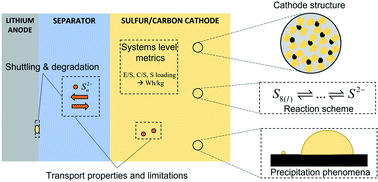Progress on continuum modeling of lithium–sulfur batteries
Abstract
While lithium–sulfur batteries are a promising next-generation chemistry devices due to their high theoretical energy density, commercialization has been slow due to low coulombic efficiency and poor cycle life. This review explores the ways in which continuum modeling contributes to the understanding of lithium–sulfur (LiS) battery mechanisms and cell-level performance through the lens of micro- and macroscale phenomena. We examine different approaches to modeling important physical phenomena such as reaction mechanisms, cathode microstructure, shuttling, nucleation and precipitation, and transport limitations. This paper also emphasizes the significance and challenge of connecting typical modeling parameters and assumptions to systems-level metrics of a standard state-of-art high performing lithium–sulfur cell. Particularly important, the considerations for high energy density cells and the areas where continuum models can facilitate better collaboration are discussed. We also summarize a few selected works to highlight experimentally-driven modeling, use of electroanalytical techniques, and parameter identification approaches to enable model-based design and advanced battery management systems.

- This article is part of the themed collection: Sustainable Energy and Fuels Recent Review Articles


 Please wait while we load your content...
Please wait while we load your content...